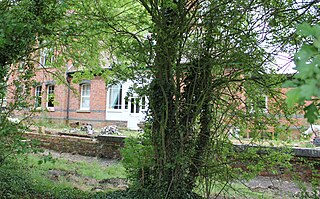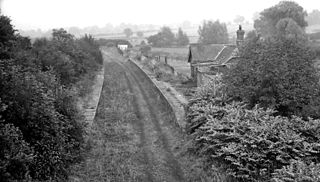The Stratford-upon-Avon and Midland Junction Railway (SMJR) was a railway company in the southern Midlands of England, formed at the beginning of 1909 by the merger of three earlier companies:

Rugby railway station serves the market town of Rugby in Warwickshire, England. The current station dates from 1885; two previous stations dating from 1838 and 1840 respectively, existed at locations to the west of the current one. It has been Rugby's only station, since the closure of the former Rugby Central station in 1969, on the now-abandoned Great Central Main Line route through the town. Between 1950 and 1970, the station was known as Rugby Midland before reverting to its original title. The station underwent an extensive remodelling between 2006 and 2008; new platforms were added and a new ticket office and entrance building were constructed. The original Victorian part of the station was retained in the upgrade.

Northampton railway station serves the county town of Northampton in England. It is on the Northampton Loop of the West Coast Main Line. The station is served by West Midlands Trains services southbound to London Euston and northbound to Birmingham New Street and Crewe. A handful of Avanti West Coast services also serve the station, however, these have been greatly reduced due to the impact of the COVID-19 pandemic in the United Kingdom.

The Northampton loop is a railway line serving the town of Northampton. It is a branch of the West Coast Main Line, deviating from the faster direct main line which runs to the west. The WCML is a four track line up to either end of the Loop: the 'up' and 'down' fast tracks take the direct route while the 'up' and 'down' slow tracks are diverted via Northampton railway station. Generally, fast express trains run via the direct line, while freight and slower passenger services run via the loop line.

Blisworth is a village and civil parish in the West Northamptonshire, England. The West Coast Main Line, from London Euston to Manchester and Scotland, runs alongside the village partly hidden and partly on an embankment. The Grand Union Canal passes through the village and the north portal of the Blisworth tunnel is near Stoke Road.

Roade is a village in Northamptonshire, England. Currently in West Northamptonshire, before local government changes in 2021 it was represented by South Northamptonshire District Council, falling within the two-member Blisworth and Roade ward.

Nassington railway station is a former railway station in Nassington, Northamptonshire. It was owned by the London and North Western Railway but from 1883 to 1916 was also served by trains of the Great Northern Railway. It opened for passengers along with Wakerley and Barrowden railway station and King's Cliffe railway station on 1 November 1879, on a new section of line constructed from Wansford Line Junction at Seaton to Yarwell Junction at Wansford.

Farthinghoe was a railway station which served the Northamptonshire village of Farthinghoe in England. It opened in 1851 as part of the Buckinghamshire Railway's branch line to Verney Junction which provided connections to Bletchley and Oxford and closed in 1963.
The Northampton and Peterborough Railway was an early railway promoted by the London and Birmingham Railway (L&BR) to run from a junction at Blisworth on the L&BR main line to Northampton and Peterborough, in England. The construction of the line was authorised by Parliament in 1843 and the 47 mile line opened in 1845. The line largely followed the river Nene, and for the economy of construction, it had many level crossings with intersecting roads, rather than bridges. In 1846 the L&BR joined with other companies, together forming the London and North Western Railway (LNWR).

Blisworth railway station was a junction station on the London and North Western Railway, the Northampton and Banbury Junction Railway, and the Northampton and Peterborough Railway. As well as providing interchange between the lines, the station served the village of Blisworth in Northamptonshire and its environs. The station was opened by the London and Birmingham Railway (L&BR) in 1838.

Olney was a railway station on the former Bedford to Northampton Line and Stratford-upon-Avon and Midland Junction Railway which served the town of Olney in Buckinghamshire, England. It was situated on a busy section of line between Towcester and Ravenstone Wood junction which saw heavy use by freight services running between Wales and north-east England. The station closed for passengers in 1962 and completely in 1964, the various connecting routes to the line having closed one by one from the 1950s onwards.

Salcey Forest railway station was a short-lived railway station in England, on the Stratford-upon-Avon, Towcester and Midland Junction Railway which opened on 1 December 1892 near the Northamptonshire forest of the same name. The station was not situated near any settlement and only saw passenger services for four months. It is most likely an error of judgement by the railway company which had provided substantial station facilities in expectation of traffic which never came. Salcey Forest station eventually closed on 31 March 1893 and has an arguable claim, along with Stoke Bruerne, of having had the shortest passenger service ever provided at any British railway station. Goods facilities were withdrawn in 1952.

Stoke Bruern railway station was on the Stratford-upon-Avon, Towcester and Midland Junction Railway which opened on 1 December 1892 near the Northamptonshire village of Stoke Bruerne after which it was misnamed. Passenger services were withdrawn on 31 March 1893. It is arguable that Stoke Bruern along with Salcey Forest have a claim to have had the shortest passenger service of any British railway station. On the first service, it was reported that one person alighted at Salcey Forest, but no-one joined, whilst at Stoke Bruern, seven joined and one alighted. The service attracted no more than twenty passengers a week and the SMJ incurred a loss of £40. The station was situated in a sparsely populated area and only saw passenger services for four months, despite the railway company's optimism which saw substantial station facilities provided in the expectation of traffic which never came. The station remained open for goods until 1952.
Tiffield was a short-lived experimental railway station situated at the highest point of the Stratford-upon-Avon and Midland Junction Railway which opened in 1869 to serve the Northamptonshire village of Tiffield, only to close two years later.

Towcester was a railway station on the Stratford-upon-Avon and Midland Junction Railway which served the town of Towcester in Northamptonshire, England between 1866 and 1964.
Wappenham was a railway station on the Stratford-upon-Avon and Midland Junction Railway (SMJ) which served the Northamptonshire village of Wappenham between 1872 and 1951. Serving a relatively rural area, the station saw considerable goods traffic generated by local farming communities, but passenger traffic was low which ultimately led to its closure.

Helmdon Village railway station on the Stratford-upon-Avon and Midland Junction Railway (SMJ) served the Northamptonshire village of Helmdon between 1872 and 1951. It was one of two stations serving the lightly populated rural area, the other being Helmdon railway station on the Great Central Main Line, and its closure marked the beginning of the years of decline for the SMJ line.

Blakesley was a railway station on the Stratford-upon-Avon and Midland Junction Railway (SMJ) which served the Northamptonshire village of Blakesley between 1873 and 1962. It was linked to nearby Blakesley Hall by a miniature railway which ran from a terminal adjacent to the station.

Morton Pinkney was a railway station on the Stratford-upon-Avon and Midland Junction Railway (SMJ) which served the Northamptonshire village of Moreton Pinkney between 1873 and 1952. It was situated not far from Sulgrave Manor, the ancestral home of George Washington's family.

The Evesham branch line is a mostly disused English railway line running from Barnt Green via Redditch, Alcester and Evesham to Ashchurch. It was sometimes known as the Gloucester loop line of the Midland Railway.

















